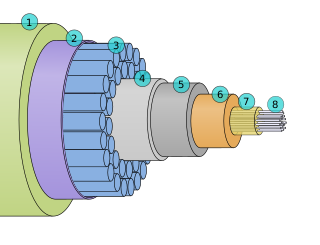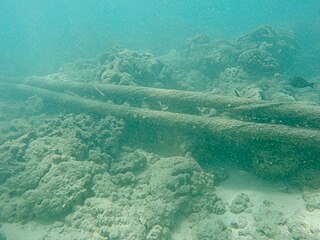
In telecommunications, a repeater is an electronic device that receives a signal and retransmits it. Repeaters are used to extend transmissions so that the signal can cover longer distances or be received on the other side of an obstruction. Some types of repeaters broadcast an identical signal, but alter its method of transmission, for example, on another frequency or baud rate.

The T-carrier is a member of the series of carrier systems developed by AT&T Bell Laboratories for digital transmission of multiplexed telephone calls.
In telecommunication, a time-assignment speech interpolation (TASI) was an analog technique used on certain long transmission links to increase voice transmission capacity.
TAT-2 was AT&T Corporation's second transatlantic telephone cable. It was in operation from 1959 to 1982, initially carrying 48 telephone circuits on two cables between Penmarch, France and Clarenville, Newfoundland. It was operated by AT&T and the national operators of Germany and France.
TAT-5 was AT&T Corporation's 5th transatlantic telephone cable, in operation from 1970 to 1993, carrying 720 3kHz channels, between Rhode Island, United States and Conil de la Frontera, (Cádiz), Spain. It had 361 repeaters.
TAT-6 was the sixth transatlantic telephone cable. It was in operation from 1976 to 1994, with a bandwidth of 12MHz between Green Hill and Saint-Hilaire-de-Riez, Vendée, (France).
TAT-8 was the 8th transatlantic communications cable and first transatlantic fiber-optic cable, carrying 280 Mbit/s between the United States, United Kingdom and France. It was constructed in 1988 by a consortium of companies led by AT&T Corporation, France Télécom, and British Telecom. AT&T Bell Laboratories developed the technologies used in the cable. The system was made possible by optical amplifiers acting as repeaters with advantages over the electrical repeaters of former cables. They were less costly and could be at greater spacing with less need for associated hardware and software. It was able to serve the three countries with a single transatlantic crossing with the use of an innovative branching unit located underwater on the continental shelf off the coast of Great Britain. The cable lands in Tuckerton, New Jersey, USA, Widemouth Bay, England, UK, and Penmarch, France.
TAT-10 was AT&T Corporation's 10th transatlantic telephone cable, in operation from 1992 to 2003, initially carrying 2 x 565 Mbit/s between United States and Norden in Germany.
TAT-12/13 is a ring cable system consisting of the 12th and 13th consortia transatlantic telephone cables, in operation from 1996, initially carrying 2 × 5 Gbit/s.
CANTAT-1 was the first Canadian transatlantic telephone cable, between Hampden, Newfoundland and eventually Grosses-Roches, Quebec and Oban, United Kingdom, which followed on from the success of TAT-1. It was conceived and approved as stage one of a proposed commonwealth round the world cable and was done at a cost of $8,500,000. The system was jointly owned by Cable & Wireless and the Canadian Overseas Telecommunication Corporation (COTC).
A transatlantic telecommunications cable is a submarine communications cable connecting one side of the Atlantic Ocean to the other. In the 19th and early 20th centuries, each cable was a single wire. After mid-century, coaxial cable came into use, with amplifiers. Late in the 20th century, all cables installed used optical fiber as well as optical amplifiers, because distances range thousands of kilometers.

A submarine communications cable is a cable laid on the seabed between land-based stations to carry telecommunication signals across stretches of ocean and sea. The first submarine communications cables laid beginning in the 1850s carried telegraphy traffic, establishing the first instant telecommunications links between continents, such as the first transatlantic telegraph cable which became operational on 16 August 1858.

Transatlantic telegraph cables were undersea cables running under the Atlantic Ocean for telegraph communications. Telegraphy is now an obsolete form of communication, and the cables have long since been decommissioned, but telephone and data are still carried on other transatlantic telecommunications cables. The first cable was laid in the 1850s from Valentia Island off the west coast of Ireland to Bay of Bulls, Trinity Bay, Newfoundland. The first communications occurred on August 16th 1858, but the line speed was poor, and efforts to improve it caused the cable to fail after three weeks.

A cable layer or cable ship is a deep-sea vessel designed and used to lay underwater cables for telecommunications, electric power transmission, military, or other purposes. Cable ships are distinguished by large cable sheaves for guiding cable over bow or stern or both. Bow sheaves, some very large, were characteristic of all cable ships in the past, but newer ships are tending toward having stern sheaves only, as seen in the photo of CS Cable Innovator at the Port of Astoria on this page. The names of cable ships are often preceded by "C.S." as in CS Long Lines.

The history of telecommunication began with the use of smoke signals and drums in Africa, Asia, and the Americas. In the 1790s, the first fixed semaphore systems emerged in Europe. However, it was not until the 1830s that electrical telecommunication systems started to appear. This article details the history of telecommunication and the individuals who helped make telecommunication systems what they are today. The history of telecommunication is an important part of the larger history of communication.

Telecommunications engineering is a subfield of electronics engineering which seeks to design and devise systems of communication at a distance. The work ranges from basic circuit design to strategic mass developments. A telecommunication engineer is responsible for designing and overseeing the installation of telecommunications equipment and facilities, such as complex electronic switching systems, and other plain old telephone service facilities, optical fiber cabling, IP networks, and microwave transmission systems. Telecommunications engineering also overlaps with broadcast engineering.
M. Robert Aaron was an American electrical engineer specializing in telecommunications.
TRANSPAC or Trans-pacific cable (TPC) is a series of undersea cables under the Pacific Ocean.

HAW-1 was the first submarine telephone cable laid between Hawaii and the mainland United States. HAW-1 was laid in 1957, and consisted of two cables, each transmitting in one direction over 36 channels, with an individual length of 2,625 Nmi (4,862 km). The cable spans between Hanauma Bay, Oahu, Hawaii and Point Arena, California.
COMPAC, the Commonwealth Pacific Cable System, was an undersea telephone cable system connecting Canada with New Zealand and Australia. It was completed by closing the last gap in Honolulu Harbor, Hawaii, at 6:25 a.m. B.S.T. on October 10, 1963. Public service of the cable commenced early in December 1963.









